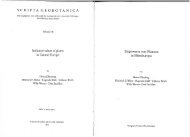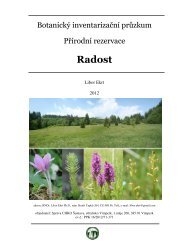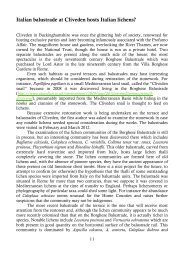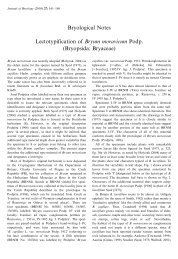Bryophyte flora of the Czech Republic: updated checklist and Red ...
Bryophyte flora of the Czech Republic: updated checklist and Red ...
Bryophyte flora of the Czech Republic: updated checklist and Red ...
Create successful ePaper yourself
Turn your PDF publications into a flip-book with our unique Google optimized e-Paper software.
844 Preslia 84: 813–850, 2012<br />
in sou<strong>the</strong>rn Moravia, <strong>and</strong> <strong>the</strong> only known example <strong>of</strong> <strong>the</strong> extant Illyric-Insubric element is<br />
Frullania inflata, known from several close by locations in sou<strong>the</strong>rn Moravia. Two primarily<br />
Alpine species that occur in <strong>the</strong> <strong>Czech</strong> <strong>Republic</strong> are Plagio<strong>the</strong>cium neckeroideum,<br />
occurring only in <strong>the</strong> Šumava Mts (Bohemian Forest) <strong>and</strong> Streblotrichum enderesii,<br />
known from one historical locality in <strong>the</strong> Krkonoše (Giant) Mts.<br />
There are very few examples <strong>of</strong> convincingly stenoendemic bryophyte species in<br />
Europe, because <strong>the</strong> ability <strong>of</strong> bryophytes to disperse is considerable <strong>and</strong> <strong>the</strong> rate <strong>of</strong><br />
speciation accompanied by observable morphological changes is relatively low. Therefore,<br />
despite <strong>the</strong> fact that many originally believed endemic species are described for<br />
Europe, <strong>the</strong>y have later ei<strong>the</strong>r been synonymized with earlier described, broadly distributed<br />
taxa, or have been recorded from o<strong>the</strong>r localities in Europe or beyond. Several dozens<br />
<strong>of</strong> broadly distributed species were originally described from <strong>the</strong> <strong>Czech</strong> <strong>Republic</strong>, including<br />
e.g. Racomitrium sudeticum described from Krkonoše Mts <strong>and</strong> Fossombronia<br />
wondraczekii <strong>and</strong> Hilpertia velenovskyi, from localities in what is now Prague. Bryum<br />
moravicum, described by Podpěra as a sou<strong>the</strong>rn-Moravian endemic from one locality near<br />
Řeznovice, was recently shown to be <strong>the</strong> oldest name for a widely distributed species,<br />
which has been known under several different names (Kučera & Holyoak 2005). Three<br />
taxa were described recently from <strong>the</strong> <strong>Czech</strong> <strong>Republic</strong>: Platyhypnidium grolleanum<br />
Ochyra, which probably represents only a rheophytic modification <strong>of</strong> Rhynchostegium<br />
riparioides, <strong>and</strong> two Orthotrichum taxa – O. moravicum <strong>and</strong> O. affine var. bohemicum.It<br />
is likely that fur<strong>the</strong>r localities <strong>of</strong> <strong>the</strong> latter two taxa will be reported from adjacent countries<br />
in <strong>the</strong> near future, as <strong>the</strong> latter taxon has been recorded in <strong>the</strong> USA (Plášek in Ellis et<br />
al. 2012). An interesting example <strong>of</strong> a relatively stenoendemic species that was described<br />
from <strong>the</strong> <strong>Czech</strong> <strong>Republic</strong> <strong>and</strong> not so far recorded elsewhere than in central Europe, is<br />
Anthoceros neesii. Although it occurs in <strong>the</strong> common, broadly distributed biotope <strong>of</strong> stubble<br />
fields in submontane regions on non-calcareous substrates, it seems to be surprisingly<br />
rare <strong>and</strong> was long regarded as having vanished from our bryo<strong>flora</strong>, until its rediscovery in<br />
2010 (Koval & Zmrhalová 2010).<br />
With respect to relic taxa, <strong>the</strong> reasons for <strong>the</strong>ir scarcity <strong>and</strong> <strong>the</strong> problems with <strong>the</strong>ir<br />
identification are <strong>the</strong> same as for <strong>the</strong> regional endemics. It can be assumed that species <strong>of</strong><br />
severely fragmented fen biotopes, which are entirely dependent on non-specific vegetative<br />
propagation, can be considered to be relics from <strong>the</strong> Ice Age. These species are generally<br />
under strong threat (Drepanocladus sendtneri, D. trifarius, Helodium bl<strong>and</strong>owii, Meesia<br />
triquetra, Paludella squarrosa, Scorpidium scorpioides) or have already become extinct<br />
(Bryum longisetum, Drepanocladus lycopodioides, Meesia longiseta). Glacial relics can<br />
also be identified among <strong>the</strong> arctic-alpine elements, although <strong>the</strong>se are more <strong>of</strong>ten species<br />
that sporulate <strong>and</strong> hence it cannot be excluded that <strong>the</strong>ir populations were sometimes<br />
boosted by propagules from <strong>the</strong> Alps or o<strong>the</strong>r mountain ranges during <strong>the</strong> Holocene. Never<strong>the</strong>less,<br />
this group <strong>of</strong> species seems to be currently declining in abundance (An<strong>the</strong>lia<br />
juratzkana, Gymnomitrion corallioides, Lophozia wenzelii, Dicranum elongatum,<br />
Grimmia elatior, Kiaeria falcata) or such species have apparently become extinct in <strong>the</strong><br />
past few decades (Gymnomitrion adustum, G. brevissimum, Arctoa fulvella, Grimmia<br />
unicolor, Ochyraea smithii, Pohlia obtusifolia, Polytrichastrum sexangulare), as a consequence<br />
<strong>of</strong> successional changes connected with <strong>the</strong> warming <strong>of</strong> <strong>the</strong> climate in <strong>the</strong> recent<br />
century.










